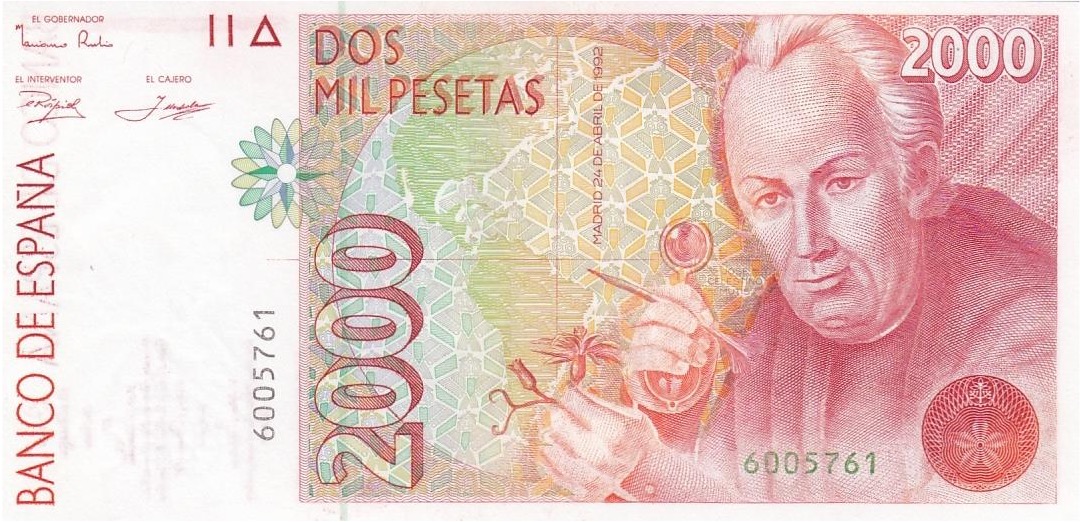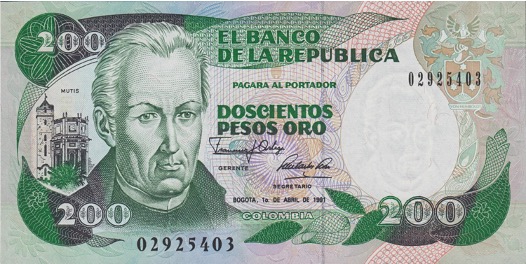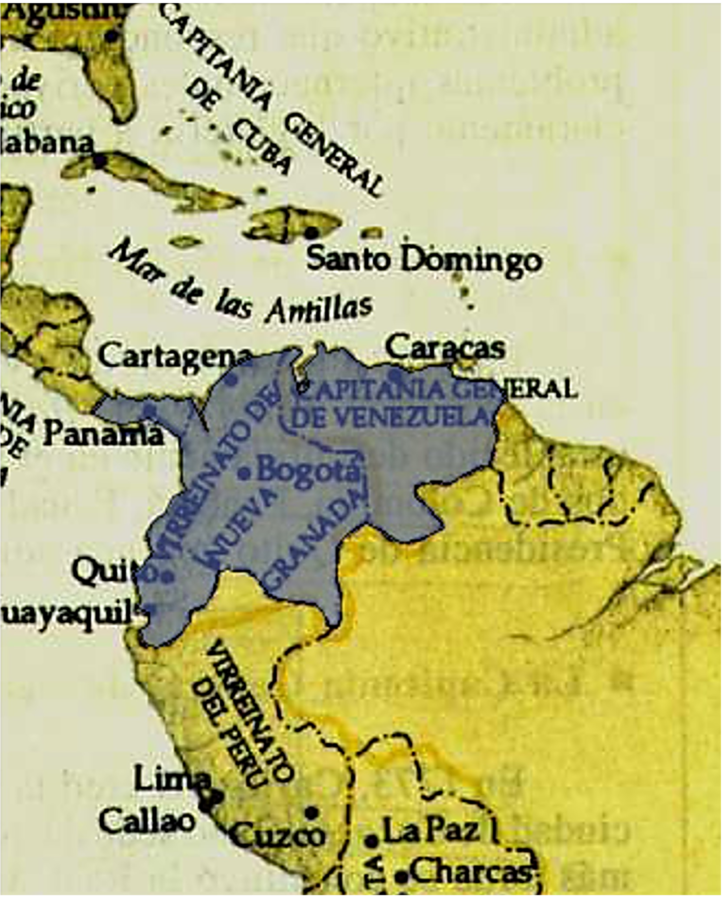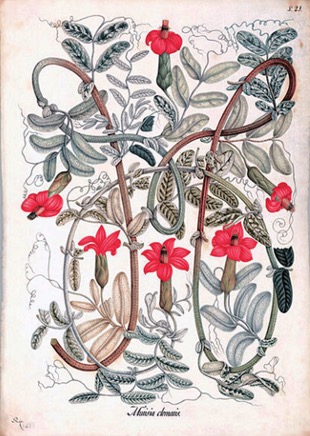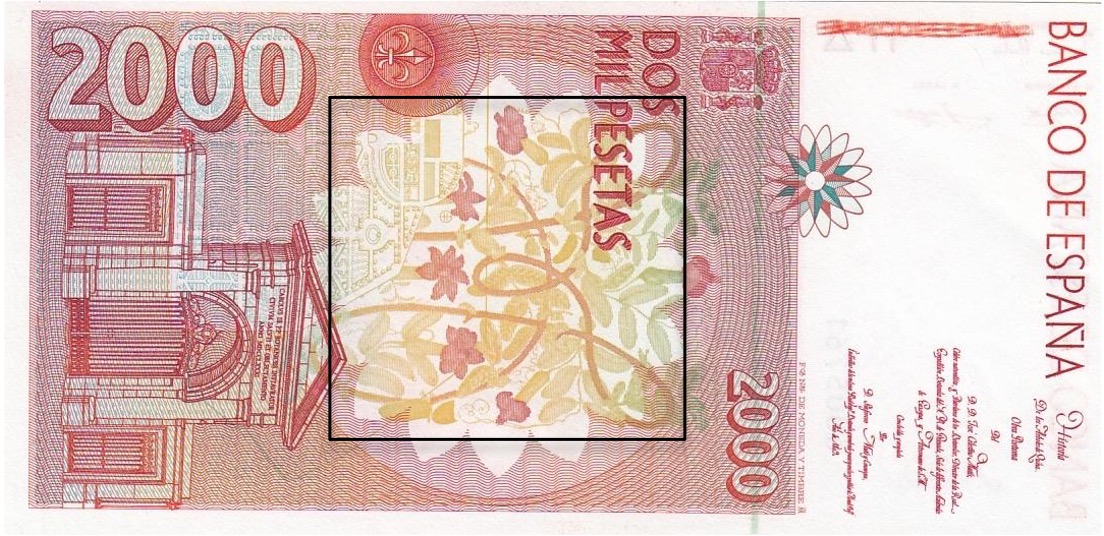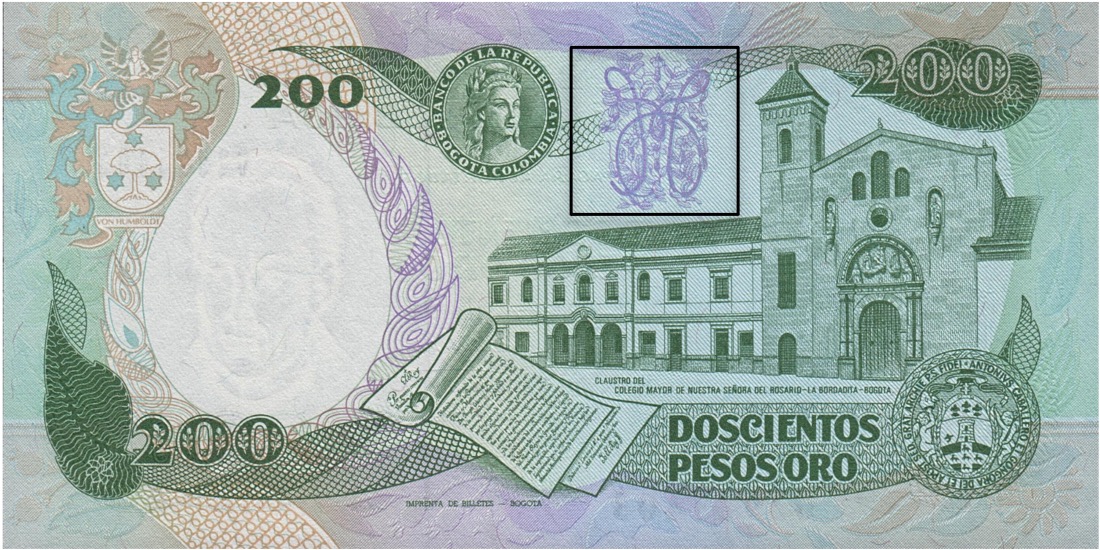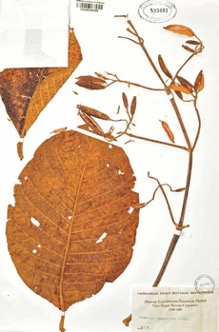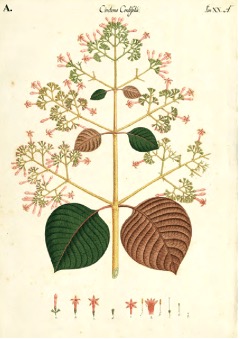Flowers of the Colony, Seeds of Independence: The Illustrations of the Royal Botanical Expedition to Nueva Granada

To commemorate the fifth centenary of Columbus’ voyage to the Americas, in 1992 the Spanish government issued banknotes emblazoned with the portrait of the cleric and botanist José Celestino Mutis (1732–1808) (Fig. 1). The Colombian government had already done the same several years earlier (Fig. 2). Mutis was a Spaniard who lived most of his life in Nueva Granada, the Spanish Viceroyalty comprising what is today Panama, Colombia, Venezuela, and Ecuador (Fig. 3). He traveled there at the age of 28 as personal doctor to the Spanish Viceroy. It was not his work as a physician, but as a botanist, and particularly his leadership of the Royal Botanical Expedition to Nueva Granada (1783-1816), that gained him a place on the currencies of both Colombia and Spain. Accordingly, both banknotes include an image of the expedition’s illustration of Mutis’ eponymous plant Mutisia Clematis (Fig. 4). This highly stylized image contorts the plant to form the letter “M.” Though not the most useful botanical illustration in terms of Enlightenment science, this flourishing monogram is a prime example of the importance of aesthetics within the enterprise of the expedition. The enduring fascination with the beauty of American nature in these images, particularly as it relates to power and Creole identity, is why they continued to be relevant on the occasion of the fifth centenary.
1 (left). 2000 pesetas, Spain, 1991-2001.
2 (right). 200 pesos, Colombia, 1983-1991.
4a. Salvador Rizo (Royal Botanical Expedition to Nueva Granada), Mutisia clematis, undated. Tempera on paper. 21.5 x 15 in (54 x 37.5 cm). Archivo Real del Jardín Botánico (CSIC), Madrid.
4b-c. Left: 2000 pesetas, Spain, 1991-2001. Right: 200 pesos, Colombia, 1983-1991. Outlines added.
The choice of a person to honor was politically delicate, as it was necessary to find notable figures that were a source of pride for both Spain and Latin America. Mutis was a convenient choice. His image did not run the risk of being associated with the violent conquest of the American continent, since the botanical expedition he led took place 200 years after first contact. Moreover, the Expedition was, at least on the surface, a purely scientific and artistic venture. Although scholars have associated eighteenth-century natural history exploration with imperialism and conquest, scientific inquiry is a rather inconspicuous form of domination. [1] However subtle, classifying and renaming the American flora and fauna according to European taxonomies, thereby concealing the native terminology and knowledge necessary to identify the specimens, is of course a form of colonization.[2] The process of integrating American plants into European encyclopedic systems erases native knowledge and participation. Recent scholarship has tried to rectify this by showing how Amerindian participation was integral to global networks of scientific knowledge in the post-contact period of European expansion, often changing modern science in the process, even when this indigenous knowledge was hidden in the process of translation.[3] Parallels between sixteenth century imperial lust for gold and silver and seventeenth and eighteenth-century efforts to find and categorize colonial plants are recognized in the commonly used term “green gold.”[4]
During the eighteenth century the Spanish embarked on three Royal Botanical Expeditions: one to the Viceroyalty of Nueva Granada, another to the viceroyalty of New Spain (1788-1802) and a third to the Viceroyalty of Peru and Chile (1777-1788). Some historians of science have suggested that the products of these eighteenth-century Spanish Royal Botanical Expeditions fit neatly within this discourse of Enlightenment science as an imperialist endeavor.[5] Others, like Jorge Cañizares-Esguerra and Antonio Lafuente have argued that botany, once it arrived in the American viceroyalties, diverged from imperialistic mercantilist goals and was instead used as a patriotic tool that served Creole elites.[6]
Even when the images of the expeditions have been closely studied, the clear differences between the visual productions of the three expeditions have not been taken into account. With their amplified color, detail, and compositional stylization, the images produced for the Nueva Granada expedition are distinct from those of the other two expeditions. Expanding Cañizares-Esguerra and Lafuente’s argument into the field of visual production, I argue that while the Nueva Granada expeditions’ illustrations are ostensibly in line with imperialistic logic by fitting American nature into Linnaean categories of order, their aesthetic surplus is a rhetorical device congruent with a patriotic celebration of local Creole identity at the expense of European scientific expansionism.
Botanical illustrations as imperialistic tools
Certainly, the three Royal Expeditions take part in the colonizing enterprise by imposing a Linnaean taxonomy onto flora that already had a native organization and vocabulary. The native names are replaced by a Latin binomial nomenclature of genus and species. These are the lowest levels of the Linnaean system in the categorization of the natural world (kingdom, phylum, class, order, and family being the other, higher levels). Class comes to bear on the taxonomy of plants, and it is determined by the categorization of their reproductive organs. Because this system was first established using European flora, all the world’s plants are brought into a scheme that originates with European standards of order. Categorizing plants by their sexual organs is a choice that allows for them to be removed from their natural environment, since nothing outside the plant itself is necessary for classification. Under this system, the name for genus and species is determined by the person who first claims the plant within the Linnaean order. Plants are often given names in honor of the botanist who first categorized them, hence Mutis’s own Mutisia Clematis.
Beyond the nomenclature, the images are created in a way that allows the plants represented to seamlessly adhere to the European system and further distance them from the natural environment from which they came. An illustration of the Ruellia is a good example (Fig. 5).[7] What appears to be a straightforward portrayal of a specimen is in fact a highly controlled and idealized representation. The plant is shown as a discrete entity, occupying almost the whole space of a folio. It floats above a blank background. Instead of an interest in the environment, what we see is an emphasis on the plant’s reproductive organs, thus readily conveying the information necessary for Linnaean categorization.[8] The lack of roots further disassociates it from the land where it naturally grows. Some illustrations include the roots, but they, too, are unconnected to any landform. The illustration shows a single plant in all essential stages of maturation in a cinematic progression (seed, bud, flower, etc.). The result is a paradigmatic image, one that synthesizes details that are unlikely to be seen together.[9] In this way, the artist conflates time and space, thereby seamlessly introducing an American specimen into the Linnaean system. By following European conventions, American flora can be understood, studied, transported, and archived in Europe.

5. Unsigned (Royal Botanical Expedition to Nueva Granada), Ruellia, undated, tempera on paper, 21.5 x 15 in (54 x 37.5 cm). Archivo Real del Jardín Botánico (CSIC), Madrid.
Studying the process from collection to illustration further separates the resulting image from the American environment. The artist’s production is mediated through the trained eye of the botanist. According to one of Mutis’ diary entries, the botanical artist does not even see the living plant in its natural environment.[10] The botanist chooses, collects, and decides which specimens are most appropriate for drawing. Finally, they even pick which parts of the specimen will be illustrated. By the time the artist begins to draw there has been an extensive process of selection. What they are drawing is often a series of parts of plants, not the plant as a whole and certainly not in any natural environment. This herbal sample of a Chinchona cordifolia, for example, contains one large leaf, a medium sized leaf (folded in half to make both front and back visible), and a cut stem with some flowers and small leaves growing midway up (Figs. 6a and b). For the image of this plant the expedition artist has extrapolated from the information of the herbal sample. The result is a symmetrical idealization of the parts of the plant present in the herbal sample. Two large leaves grow from a central stem; the one on the left displays the front of the leaf, and thus is painted bright green, while the one on the right shows the back and is brown. Above them, branching out from the same bud as the leaves, grow two branches, one towards the left, one towards the right, both in full bloom with delicate pink colored flowers on their ends. This same pattern is repeated two more times going up the stem, each time, the branches with alternating brown and green leaves diminish in size. The stem is topped by three barely budding branches, one to each side and one straight above, each revealing the slight pink of the newly flowering buds.
6a-b. Left: Herbarium sample. Right: Unsigned (Royal Botanical Expedition to Nueva Granada), “Chinchona cordifolia”, undated. Tempera on paper. 21.5 x 15 in (54 x 37.5 cm). Archivo Real del Jardín Botánico (CSIC), Madrid.
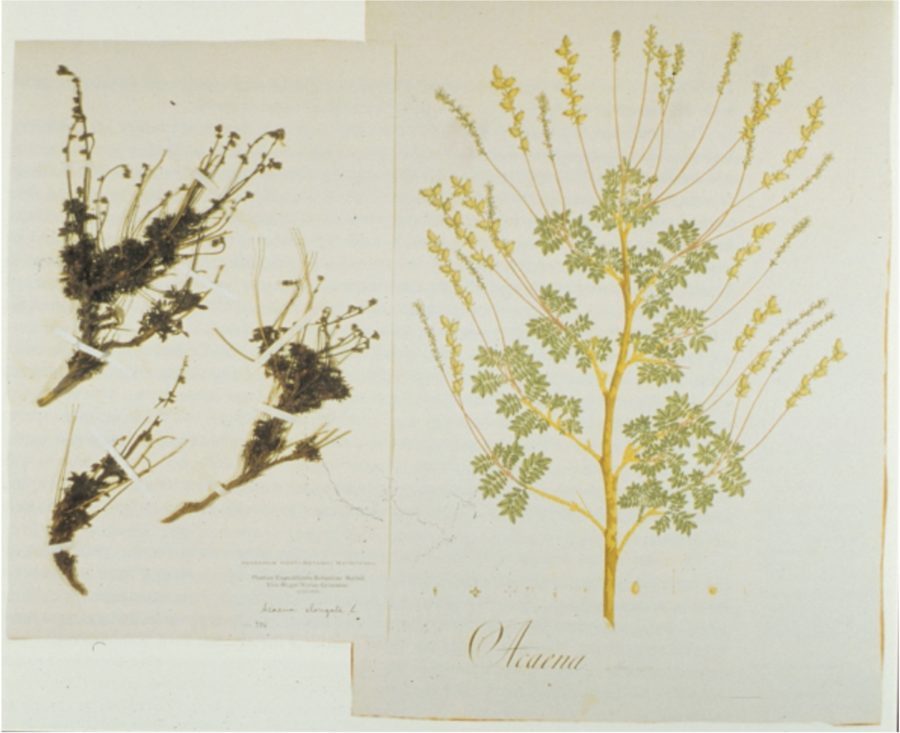
7. Left: Herbarium sample. Right: Unsigned (Royal Botanical Expedition to Nueva Granada), Acaena, undated. Tempera on paper. 21.5 x 15 in (54 x 37.5 cm). Archivo Real del Jardín Botánico (CSIC), Madrid.
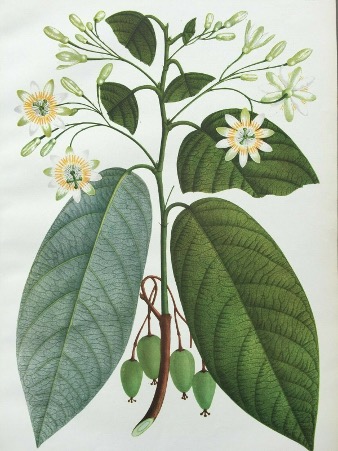
8. Unsigned (Royal Botanical Expedition to Nueva Granada), Passiflora arboreans, undated. Tempera on paper. 21.5 x 15 in (54 x 37.5 cm). Archivo Real del Jardín Botánico (CSIC), Madrid.
The illustrations betray an intense process of selection and preservation. Here only the information considered necessary for a Linnaean identification is displayed. Examining an illustration of the Acaena plant along with its herbal sample further emphasizes the artificiality of the process (Fig. 7). The herbal sample is a collection of three separate branches. From these pieces the artist creates a highly symmetrical illustration of a whole plant. The Acaena, as imagined by this artist, has only one central stem. From this stem burgeon four pairs of branches. They are evenly spaced along the extension of the page. Each branch has its mirror image. The slight imperfection in the symmetric scheme, where one branch has three blossoming twigs and its mirror only two, imbues the image with an air of plausibility, without threatening the imposed harmony of the composition. In lieu of this realistic touch, illustrations often show broken or dying leaves, as in the Passiflora arborea (Fig. 8). The illustrations are indeed composed idealizations of a tame, organized nature. Like the logic of the Linnaean system itself, the illustrations disassociate the American plants from their environment and from native understanding, while making the new system appear natural.
Color and flatness as rebellion
Rather than imagining Mutis’s expeditionary project as a final colonizing gesture, Colombians have honored him as a forefather of their independence. A portrait of Mutis housed in the National Museum in Bogotá, for example, shows his bust resting atop a pedestal (Fig. 9). Open books and botanical illustrations, along with a celestial globe lay on the floor. The Mutisia clematis climbs around the pedestal, connecting the signifiers of knowledge with the botanist’s bust and wrapping both the man and his European totems in local American nature growing from American soil.

9. Salvador Rizo, Embodied Bust of José Celestino Mutis, ca. 1811. Oil on canvas. 46.5 x 40 in (118×104 cm). Museo de la Independencia, Casa del Florero, Bogotá, Colombia.
Mutis was a loyal subject to the Crown and the notion that he is a precursor of independence is unfounded. The popular Colombian association between Mutis and the revolutionary movement can be partly explained by the timing of his expedition, which coincided with efforts of the Creole elite of Nueva Granada to gain independence from the Spanish Empire. It is true that all of the botanists and several of the artists of the expedition were directly involved in the independence movement, if not Mutis himself.
One could insist that the expedition documents are nothing other than tools for the domestication of the American natural world, and that Mutis’ association with independence is simply a wishful reinterpretation of the facts. One could even consider the hailing of Mutis as a forefather of Colombian independence to be a manifestation of the local elite’s desire to be considered European. After all, Creoles, American-born people of Spanish descent, were denied access to the highest echelons of colonial power. The independence movement can be understood as an expedient way for them to obtain the power Spaniards were already holding in the Americas.
The rationale for denying power to the Creole population varied throughout the centuries and in different Viceroyalties, but by the Enlightenment, a Eurocentric racial theory that centered on the inferiority of indigenous people of the Americas provided a ready justification. This idea originated with naturalist Georges-Louis Leclerc but took hold in the European imagination with the writings of scientists Comte de Buffon and Cornelius de Pauw. Their hypotheses espoused that the humid climate of the Americas was degenerate and led to smaller, weaker animals, including human beings, making American people inferior to Europeans.[11] De Pauw’s theories extended Creoles:
The Europeans who pass into America degenerate, as do the animals: a proof that the climate is unfavorable to the improvement of either man or animal. The Creoles, descended from Europeans and born in America … have never produced a single book. This degradation of humanity must be imputed to the vitiated qualities of the air stagnated in their immense forests, and corrupted by noxious vapours from standing waters and uncultivated grounds.[12]
These ideas had tangible political consequences for the artists and botanists of the Expedition. Creoles, although sharing the same blood as Spaniards, found it difficult to rise in the ranks of both the administration and the church during colonial rule.
The illustrations of the Nueva Granada, however, display, if not outright revolutionary ideals, at least a good dose of local pride. This local patriotic inflection is most evident when we compare the Nueva Granada artistic production to the botanical illustrations produced in other contemporaneous Royal Botanical Expeditions.
The decrees that created the three Royal Expeditions were similar, but their leadership, scale, and length were markedly different. The expedition to Peru and Chile, led by the Spanish naturalists Hipólito Ruiz and José Pavón lasted nine years, employed three to five artists, and produced around 2,300 images. The expedition to New Spain, led by the Spanish naturalists Martín de Sessé and José Mariano Mociño, also lasted nine years, employed two artists and produced around 2,200 images. By comparison, the expedition to Nueva Granada, led by the cleric Mutis, lasted thirty-three years, employed around sixty artists and produced a total of 5,397 illustrations (2,945 in color and 2,498 in ink). The archive also holds 735 small drawings of “anatomies” of the flower and their structures, as well as eighty-eight prints that represent the germination of various plants.[13] The majority of the Nueva Granada illustrations are made in folio size paper (53 x 34cm); seventy-two are double that size, and only seventy-five are smaller, compared to the half and quarter-size folios used in the other two expeditions.
10 (left). Unsigned (Royal Botanical Expedition to Nueva Granada), unnamed plant, undated. Tempera on paper. 21.5 x 15 in (54 x 37.5 cm). Archivo Real del Jardín Botánico (CSIC), Madrid.
11 (right). Unsigned (Royal Botanical Expedition to Nueva Granada), Guana, undated. Tempera on paper. 21.5 x 15 in (54 x 37.5 cm). Archivo Real del Jardín Botánico (CSIC), Madrid.
The Nueva Granada illustrations also distinguish themselves in style and color. They are not drafts for a future print, but finished products, meticulously drawn and painted. Figs. 10 and 11, from the Mutis workshop, are two examples among hundreds of equally painstaking renditions. The compositions harmoniously occupy most of the page. The leaves and flowers are scrupulously rendered, giving the sense that every vein and striation of the specimens has been translated onto the page. Even the thin pistils have been colored in with such delicacy that no pigment extends beyond their contours. The quality of this tempera paint is difficult to see in reproductions as photography eliminates much of its texture. The many layers of carefully applied paint have a dimension that makes it appear that the pigment is almost floating above the page.
The attention to color and detail is even more surprising in comparison to the other two expeditions and when one considers the purpose of this effort. The result of these expeditions was to be published in lavish volumes back in Spain. This task was never completed. Publication was delayed because of a combination of factors, including the Napoleonic invasion of 1808 and the independence wars of the colonies in the first decades of the nineteenth century. The only books on American flora published under colonial rule were the first three volumes of the expedition to Peru and Chile led by botanists Hipólito Ruiz López and José Antonio Pavón Jiménez. The illustrations along with the published results from this project exemplify the purpose that drawings had within the overall aims of the Spanish Royal Expeditions. The excessive attention paid to artistic quality, and to color in particular, in the Nueva Granada illustrations is clear when one compares them with those produced for the expedition to Peru and Chile.
The publications of the Peru and Chile expedition are adorned with prints of the various plants and their anatomies. The illustrations prepared in the Americas were used only as models for the copper plates; the resulting engraving was the image that the public at large would see once the projects were complete. Accordingly, the leaders of the enterprise did not focus too much effort on the hand-painted icons. Ruiz and Pavón were Spanish-born men who traveled to America only for the purpose of the expedition. They gathered their information as quickly as possible, spending less than a decade in the New World. The majority of their time as part of the expeditionary project was spent in Spain (from 1788-1802), where they classified their results and produced the printed editions (1798-1802).
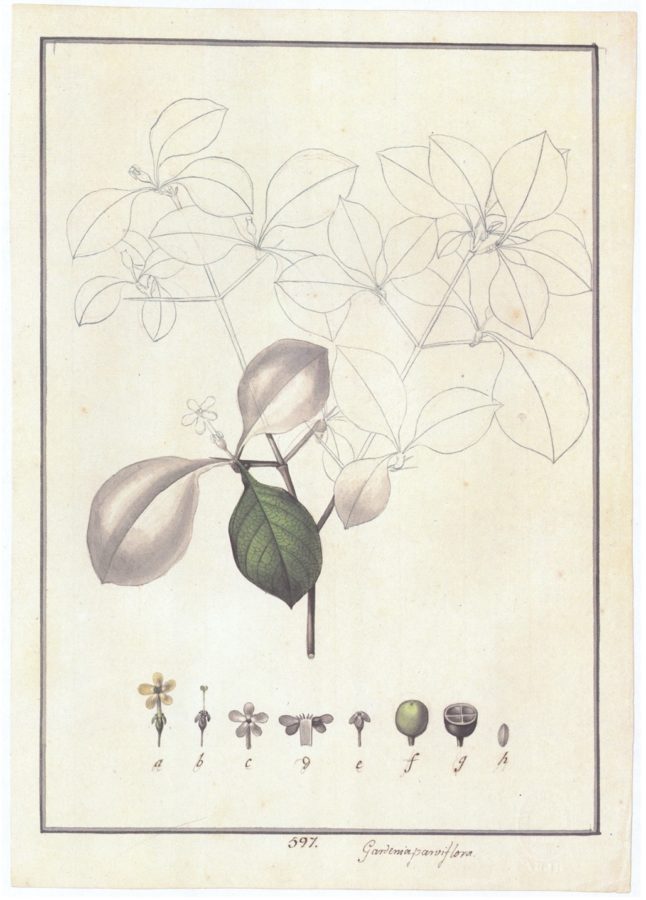
12. Unsigned (Royal Botanical Expedition to Peru and Chile), Gardenia parviflora, 1898. Pencil and watercolor on paper. 11 x 7.5 in (27.94x 19.05 cm). Archivo Real del Jardín Botánico (CSIC), Madrid.
13 (left). Engraving of ‘Chinchona Purpurea’ in Hipólito Ruiz and José Pavón, Flora Peruviana et Chilensis (Madrid: Typis Gabrielis de Sancha, 1789-1802), plate CXCIII.
14 (right). Javier Cortés y Alcocer (Royal Botanical Expedition to Peru and Chile), Chinchona, 1872. Pencil and watercolor on paper. 21.5 x 15 in (54 x 37.5 cm). Archivo Real del Jardín Botánico (CSIC), Madrid.
The illustrations from Peru and Chile were often sketches that merely hinted at the general form and color of the plant. The Gardenia Parviflora illustration, for example, is almost completely unpainted (Fig. 12). The anatomies of the bud and flower, necessary for the Linnaean classification, as well as a single leaf on the bottom part of the plant, are the only items colored. Two other leaves are shaded in with watered ink, but the rest of the plant is only drawn in outline. The detail rests solely on the lone painted leaf. Its veins are assiduously traced, and the careful modeling emphasizes its volume. The details for all other leaves could be extrapolated from this one example and added to the copper plate upon arrival in Spain.
Some of the illustrations are certainly more polished than the example here. But even in these instances the print displays more details than the painted illustration. What is more, there are considerable changes in form from one medium to the other. The print for Chinchona purporea, for example, although obviously inspired by its colored illustration, has more leaves and displays more of the developmental stages of the plant (Figs. 13 and 14). The painting is an awkward composition, with much of the page left blank. In it, the plant is unnaturally stiff. Its branches create rigid crosses in their intersection with the single stem. The only attempt at the semblance of movement is on the bottom leaves, with one twisting to show its backside. In contrast, the print is a rich, lively representation. Leaves, flowers, and buds occupy almost the whole surface of the page. The central stem is slightly turning towards the left and its many leaves twist showing their tops and bottoms. In addition, many of the anatomies already available in the illustration have been corrected for the print and they display a larger number of developmental stages of the plant’s reproductive organs.
The general disregard for tidiness is a characteristic of all the painters who participated in the Peruvian expedition. In the Chinchona purpurea, for example, the painter Xavier Cortéz colors beyond the black outlines of the bottom leaf. A detail of the painting of a Periphraginos by José Rivera exhibits the same carelessness in the coloring (Fig. 15). The yellow spreads far beyond the outer lines of the flowers.
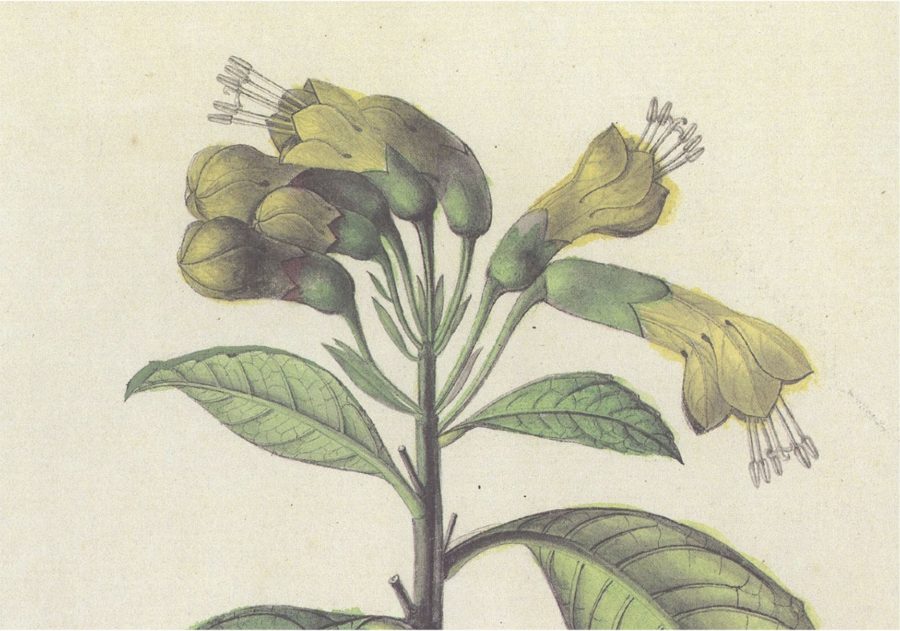
15. Unsigned (Royal Botanical Expedition to Peru and Chile), unnamed plant, undated. Pencil and watercolor on paper. Approx. 4.33 x 5.9 in (11x 15 cm). Archivo Real del Jardín Botánico (CSIC), Madrid. Detail.

16. Unsigned (Royal Botanical Expedition to Nueva Granada), Scleria macrophylla, undated. Tempera on paper. 21.5 x 15 in (54 x 37.5 cm). Archivo Real del Jardín Botánico (CSIC), Madrid.
In contrast with the sketchy nature of the Peruvian illustrations, those of Nueva Granada are intricately detailed, with carefully applied tempera colors. There are also stylistic differences, with a noticeable flattening of the image. Although many botanical illustrations share in the process of being drawn from live specimens that have been pressed, essentially squeezing the three-dimensional branches and flowers into the two-dimensional space of botanical catalogues, only the ones from the Nueva Granada expedition look so noticeably flat. Some illustrations display a compositional exuberance that enhances this aspect. In Fig. 16, for example, the leaves of the plant have been used to create a zig-zag geometric pattern across the whole page. Instead of verisimilitude, the artist produces a highly stylized pattern that overlays the illustration of the other parts of the plant. It seems deliberately produced to show the artist’s skill and imagination, rather than aid scientific identification.
The flatness of the illustration echoes more directly the Andean style often seen in “Angeles Arcabuceros” in the second half of the seventeenth century and most commonly associated with the Cuzco style, but also present in contemporaneous workshops in Quito, Popayán, and Santa Fé de Bogotá (Fig. 17). Angeles Arcabuceros are often dressed in the elaborate clothing of Andean nobles and aristocrats. Their delicate bodies are almost overtaken by their huge colorful and brocaded sleeves. They stand centered in the foreground, breaking their bilateral symmetry by placing one foot slightly ahead, shifting their heads to one side, and of course, by displaying their single gun. The extreme decoration of their sleeves, although implying puffiness, actually has the effect of compressing their outfits. They are not unlike the Nueva Granada botanical images, with intricate, colorful details, emphasizing a calibrated symmetry and carefully composed frontality. The style of the illustrations references this markedly Andean style, detaching the images and, by extension, the American flora they represent, from a strictly European representational system.
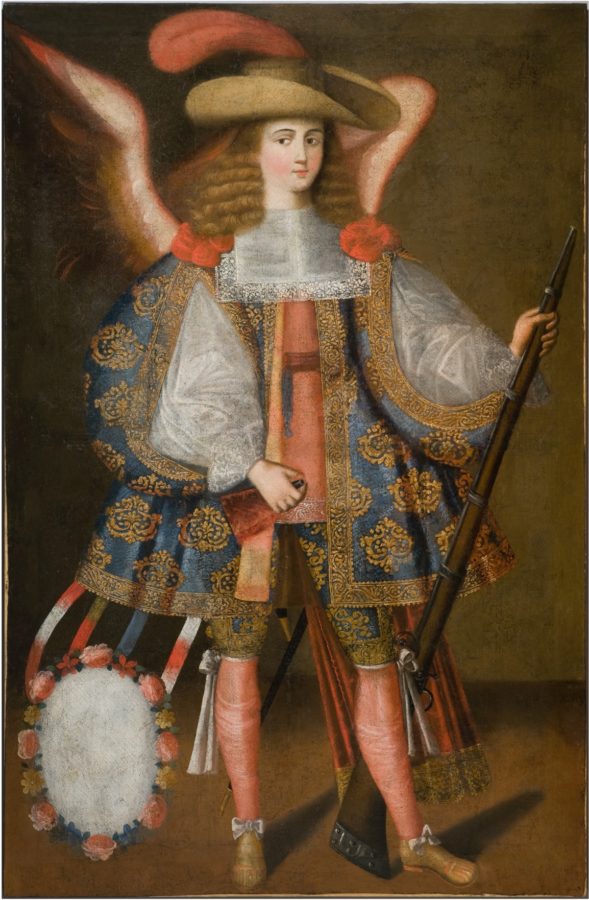
17. Unknown artist, Angel Arcabucero [Angel with Harquebus], 18th century. Oil on canvas. 64 3/4 x 44 1/2 in. (164 x 113 cm). Collection of Carl & Marilynn Thoma.
This similarity in style is not coincidental. Mutis, who, unlike the leaders of the other two expeditions, had not crossed the Atlantic for his scientific endeavor, but was already living in Nueva Granada and had a commitment to the land and its people, might have already been partial to this Andean style. What we know for sure is that he found the two Spanish artists he tried to hire to have a “lack of docility” that would have lent itself to being instructed on how to paint botanical specimens.[14] Mutis eventually hired five young artists from two renowned Quito schools in 1787. A few years later, in 1790, he hired another five artists from Quito. During the 1790s Mutis hired another ten men from schools in Popayán (southern Colombia) and Santa Fé de Bogota. These principal painters then trained younger artists in the style of the expedition.
The attention and labor invested in the Nueva Granada illustrations unnecessarily delayed the process of data collection and publication. This is surprising given that during the Enlightenment, illustration was a matter of contention in regard to the study of botany.[15] Linnaeus himself questioned the usefulness of illustrations given the changeability of nature. Early in his career, the prominent botanist produced illustrations of plants as an aid to his verbal descriptions, but he later discarded this practice because he considered it too insubstantial to be used in scientific inquiry. Linnaeus writes:
I do not recommend the use of images for the determination of genera. I absolutely reject them—although I confess that they are more pleasing to children and those who have more of a head than a brain. I admit that they offer something to the illiterate […] But the invention of writing provides an easier and more certain way of communicating ideas. So even in botanical matters before the discovery of letters, these figures were of the greatest help; but once [letters were] to hand, one could follow a much shorter road: we have 26 letters with which to write our ideas [….] [W]ho ever derived a firm argument from a picture? [….] If the parts differ in the same genus, as in many, and as they do in number and by appearance in distinct species, I would still try to convey the location and proportion of the parts. I can in no way express this in an image, unless I gave an equal number of figures. If therefore there were 50 species and the same number of differences, I would have to provide the same number of pictures. Who could ever derive any certainty from such a large number [… ?] And so we shall try to express all the characters equally clearly by means of words, and maybe even more clearly than the others with their splendid pictures.[16]
Linnaeus’ argument against illustrations echoes some of the arguments Europeans raised in the sixteenth century and beyond against American natives. For the Europeans, the lack of alphabetic writing and reliance on pictures within indigenous American cultures was considered proof of their arrested state of development and their natural inferiority to Europeans.[17]
Regardless of Linnaeus’s disapproval, amongst the papers of the Nueva Granada expedition, there is lively discussion about the discovery and preparation of new colors for the purpose of accurate and beautiful botanical representation of plants.[18] This intense attention paid to color and detail in modeling in the Nueva Granada pictures is enigmatic in light of the use of illustration in the other expeditions and Mutis’s familiarity with and admiration for Linnaeus.[19] Why would Mutis devote a vast amount of the resources of the expedition to the production of delicately detailed illustrations when they were to be transferred to black and white prints? Why not work as the leaders of the Peruvian expedition had?
One possible answer for Mutis’s attention to the artistic quality of the illustrations is quite simply that his lack of scientific training led him to move away from botanical description and to rely more heavily on illustration. Mutis was internationally recognized for his “discovery” of the chinchona species of quina (the (plant from which quinine is made). Quinine was a significant trade item during the Enlightenment because it was used in the treatment of malaria. However, when Humboldt visited Nueva Granada he marveled that it took Mutis over a decade to “discover” the plant, given that it was so widespread in the area.[20] Moreover, in his letters, Humboldt also points out a series of errors Mutis committed with respect to the medicinal plant. By focusing so profoundly on the illustrations, the self-taught botanist could ignore his scientific deficiencies while producing an enviable body of artistic work. Nevertheless, although the scientific descriptions might have been lacking, the use of the Linnaean taxonomy placed his work within the Enlightenment order, allowing it to appear as science.
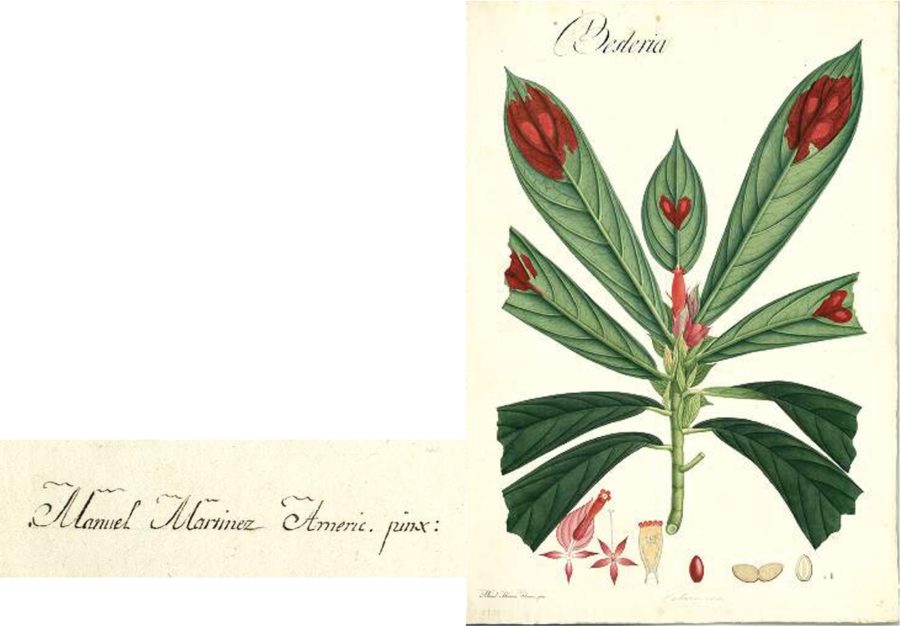
18. Manuel Martinez (Royal Botanical Expedition to Nueva Granada), Besleria, undated. Tempera on paper. 21.5 x 15in (54 x 37.5 cm). Archivo Real del Jardín Botánico (CSIC), Madrid.
Yet this account of Mutis’ project’s relation to Linnaean values fails to explain another puzzling difference between the Nueva Granada illustrations and those of the other expeditions. Over half of the illustrations from Mutis’s project are signed. And of these, the most meticulously crafted examples—in a way the most extravagant drawings, those that go beyond mere anatomical accuracy to record a dazzling array of colors, accurate shading, and magnificent modeling—are marked with the rubric “Americanus pinxit” (Fig. 18). Because of their beauty, these examples warrant the artists to announce their origin: they are American productions.
This local pride is also found in the plant nomenclature itself. Aside from the eponymous Mutisia Clematis, already mentioned, as well as those named after the Spanish Viceroys who authorized and supported the Expedition (Antonio Caballero y Góngora, Antonio Amar y Borbón, and José de Ezpeleta), there are also plants honoring American contributors, including artists Salvador Rizo and Francisco Javier Matis and, shown here, naturalists Francisco Caldas and Eloy Valenzuela (Figs. 19 and 20).
19 (left). Unsigned (Royal Botanical Expedition to Nueva Granada), Valenzuela coccinea, undated. Tempera on paper. 21.5 x 15 in (54 x 37.5 cm). Archivo Real del Jardín Botánico (CSIC), Madrid.
20 (right). Unsigned (Royal Botanical Expedition to Nueva Granada), Caldasia, undated. Tempera on paper. 21.5 x 15 in (54 x 37.5 cm). Archivo Real del Jardín Botánico (CSIC), Madrid.
The excessive color is almost an affront to the strict European Linnaean structures. It turns instead to focus on something Creoles, not Europeans, found significant in nature. The expedition’s Creole artists’ attention to color is a direct reaction to European scientific as well as philosophical claims of American inferiority. The attention to design, style, and color responds to the European discourse of American inferiority in two ways. First, it demonstrates the artistic excellence of Creoles, who could outdo even their European counterparts.[21] Mutis had a vested interest in portraying the talent of the people he lived among and educated for decades. The title appended to the image thereby displays the pride of an American in conquering a European art.
Second, these illustrations display pride not only in the capacity to paint striking botanical illustrations, but also in the richness and beauty of the flora itself. Some American Creoles, like Charles Wilson Peale, for example, engaged in the scientific dispute by disproving European claims that the American climate did not allow for large mammals, showing proof of mastodons’ bones. Thomas Jefferson tried to disprove Buffon by providing him with a panther’s skin. The scientists of Nueva Granada used a different strategy to combat the insult. They did not try to disprove the facts upon which the hypothesis was based (i.e., they did not point to large animals), but instead adhered passionately to their geography and their exuberant flora.[22] They answered European degradation with solipsistic admiration for the beauty of the American territory. Francisco José de Caldas, who died by firing squad for his participation in the first and failed independence of Nueva Granada, did not question Buffon’s suggestion that animals in America are smaller. Instead, he challenged de Pauw’s suggestion that the climate is degenerate. To counter de Pauw’s claims that the American climate produces degenerate animals and among them humans, he both questioned the European climate, and glorified the flora of his own climate:
We do not wish to infer from this, as does de Pauw, that obstinate enemy of all things in America, that the cold of this vast continent is extraordinary, that it has caused the extinction of the larger animal species [….] [T]ell us whether Nueva Granada is colder than Prussia, Germany, and all those countries in which man has reached perfection; whether here the cold can produce the dreams and fancies he invented, without warrant or knowledge, about the most beautiful and fruitful country in the world.[23]
Caldas mentions the Prussian cold as being responsible to the extinction of large animals, but also highlights the diversity of zones in Nueva Granada as producing unmatched fruitful beauty.[24] To European scientific disdain, Creoles responded by calling attention to the aesthetic value of their nature. This impassioned flaunting of American geography is an outright rejection of the Enlightenment universalism that placed them as inferior to Europeans.
The insistence on color and a native style, beyond any scientific usefulness, had a patriotic ring during the turbulent political situation that led to independence. Europeans blamed the environment for Creole inferiority; and Creoles in turn retorted with pride in the continent’s natural beauty, which they saw as being a result of their climate. Although Mutis was an avid royalist, his sharing in the Creole sense of wonder aligns him, at least retrospectively, with the precursors of the independence movement.
The Nueva Granada expedition’s call to wonder, expressed in the images’ excess of color, Andean style, and large format offered a strategy of defiance against the then-prevalent notion of American inferiority. Colombian patriotism is so tied to this response that we continue to rely on this defensive strategy. Colombians often have copies of botanical expedition images in their homes. The expedition and its illustrations continue to be a sort of shorthand that connects present status to the power of Creole ancestors.[25] The images of the botanical expedition, hanging in hallways and museums, are constant reminders of the aesthetic response that Nueva Granada made to criticisms of Creole inferiority. They are a practiced defense against European and, more recently, Anglo-American perceptions of Colombian subordination. To the reproach that our nation is drug-infected, we answer, “Oh sure, drugs, but have you ever seen such beautiful nature?” Wonder remains the answer of Colombians to notions of inferiority. Our national identity, from independence onwards, remains closely tied to the beauty of our natural world. As much as these images are evidence of colonial subjectivity, they also point towards Creole self-representation and they endure as they do because the global power structure under which they were created still echoes.
The Spanish choice to place Mutis on the peseta is unsurprising given his role in the colonizing enterprise. Given the rhetorical force of the illustrations’ stylistic properties described here, it is also no wonder that Colombia would choose to place a Spanish cleric on their currency as the quincentennial of conquest approached. The images of the expedition endure within the Colombian imaginary because wonder and an appeal to natural beauty—on Creole terms—remains an integral response to denigration in the face of imperial power.
- [1] See Arthur Robert, Flowers from the King. The Expedition of Ruiz and Pavón and the Flora of Peru (Durham: Duke University Press, 1964); Anthony Pagden, The Fall of Natural Man: The American Indian and the Origins of Comparative Ethnology (Cambridge: Cambridge university Press, 1982) and Spanish Imperialism and the Political Imagination (New Haven: Yale University Press, 1982); Barbara M. Stafford, Voyage into Substance: Art, Science, Nature, and the Illustrated Travel Account 1760-1840 (Cambridge: MIT Press, 1984); Mary Louise Pratt, Imperial Eyes: Travel Writing and Transculturation (London and New York: Routledge, 1992); Mauricio Nieto Olarte, Remedios para el imperio: Historia natural y la apropiación del Nuevo Mundo (Bogotá: Instituto Colombiano de Antropología e Historia, 2000); Daniela Bleichmar, Visible Empire: Botanical Expeditions and Visual Culture in the Hispanic Enlightenment (Chicago and London: University of Chicago Press, 2012).
- [2] This is not to say that all eighteenth-century European naturalists sought to categorize plants under European standards of order alone. Some criollo authors, as Jorge Cañizares-Esguerra suggests, show ambivalence towards indigenous sources, sometimes dismissing them outright and other times privileging them. Cañizares-Esquerra proposes that Francisco Xavier Clavijero, for example, a Jesuit working in Mexico at the same time as Mutis is in Nueva Granada, saw himself as an heir to the historiography of the sixteenth century and considered some indigenous sources reliable. In fact, Clavijero thought that the ignorance of native tongues was partly responsible for European errors in the classification of nature. He praised the Spanish Francisco Hernandez’s use of Nahuatl names and even taxonomies in his great Renaissance opus De Antiquitatibus Novae Hispaniae (compiled between 1571 and 1576). See Cañizares-Esguerra, Como escribir la historia del Nuevo Mundo (México: Fondo de Cultura Económica, 2007), 419-420. Also see Francisco Xavier Clavijero, Historia antigua de México (México: Porrua, 1964), 477-479 and 500.
- [3] See, for example, Jaime Marroquín Arredondo and Ralph Bauer, Translating Nature: Cross-Cultural Histories of Early Modern Science (Philadelphia: University of Pennsylvania Press, 2021) and Susan Scott Parish, American Curiosity: Cultures of Natural History in the Colonial British Atlantic World (Williamsburg, Virginia: University of North Carolina Press, 2012).
- [4] Londa Schiebinger condenses these parallels in the term “green gold.” She states: “Early conquistadors entered the Americas looking for gold and silver. By the eighteenth century, naturalists sought ‘green gold’”(Londa L. Schiebinger, Plants and Empire: Colonial Bioprospecting in the Atlantic World [Cambridge, Mass.: Harvard University Press, 2004], 7); elsewhere, she writes, “While Spanish conquistadors had entered the America’s looking for gold and silver, by the seventeenth century Europeans increasingly turned their attention to ‘green gold’” (Londa L. Schiebinger, “Prospecting for Drugs: European Naturalists in the West Indies,” in Londa L. Schiebinger and Claudia Swan, eds., Colonial Botany: Science, Commerce, and Politics in the Early Modern World, [Philadelphia: University of Pennsylvania Press, 2005], 119). Also see Jorge Cañizares-Esguerra, “How Derivative Was Humboldt? Microcosmic Nature Narratives in Early Modern Spanish America and the (Other) Origins of Humboldt’s Ecological Sensibilities,” in the same volume, 163. However, Paula De Vos suggests that the search for “green gold” did not begin with the Northern European Linnaean Enlightenment project to catalogue the natural world, as Schiebinger and others have proposed, but is evident as early as the sixteenth century in Spanish state sponsored transplantation efforts. Paula De Vos, “The Science of Spices: Empiricism and Economic Botany in the Early Spanish Spanish Empire,” Journal of World History, vol 17, no. 4 (2006), 401.
- [5] See Nieto, Remedios, and Bleichmar, Visible Empire.
- [6] Jorge Canizares-Esguerra, Nature, Empire and Nation: Explorations of the History of Science in the Iberian World (Stanford: Stanford University Press, 2006), and Antonio Lafuente, “Enlightenment in an Imperial Context: Local Science in the late Eighteenth-Century Hispanic World,” Osiris, 2nd series, vol. 15, Nature and Empire: Science and the Colonial enterprise, (2000), 155-173.
- [7] See Bleichmar, Visible Empire, ch. 3; Nieto, Remedios, ch. 2.
- [8] Linnaeus defined classes of plants based on their reproductive organs. He focused on a plant’s sexual morphology—the number, size, and method of insertion of their stamens, and the number of pistils. He did not look at the whole plant or its environment in his organization of the botanical world.
- [9] Michael Lynch and John Law, “Pictures, Texts, and Objects: The Literary Language Game of Bird-Watching,” in “Pictures, Texts, and Objects: The Literary Language Game of Bird-Watching,” in Mario Bagioli, ed., The Science Studies Reader (New York: Routledge, 1999), 333.
- [10] “Since Roque and Esteban arrived at the Herbals with many and not common plants, I have put the best exemplars in water for the successive formation of illustrations, doing what I am accustomed to in such occasions: that is, the whole plant gets delineated, the anatomy of the fructification is made, and the leaves are painted, two [showing] the front and another the back; although for some, in order to gain time, this last step is left for later by conserving them in water” (“Como han llegado a los herbarios Roque y Esteban con muchas y no comunes plantas, he puesto en agua los mejores ejemplares para la sucesiva formación de las láminas, haciendo lo que acostumbro en tales ocaciones: esto es, se delinea toda la planta, se hace la anatomía de la fructificación, y quedan pintadas dos hojas una al derecho y otra al revés; aunque de algunas para ganar tiempo se dejará de hacer esto último conservándolas en agua”). Mutis’ diary is cited in Lorenzo Uribe Uribe, “Los maestros Pintores” in Flora de la Real Expedición Botánica del Nuevo Reino de Granada (Bogotá: Instituto Colombiano de Cultura Hispánica, 1954), 102.
- [11] “In essence the basic theme of so many diatribes was, quite simply, the notion of the presumed inferiority of the nature of America, and especially its fauna, including man, in comparison with the Old World’s and the resulting unavoidable decadence and corruption to which the whole Western hemisphere found itself condemned: a rudimentary theme, clearly, but one that bred prolifically, producing innumerable variations and reverberating with multiple echoes, in philosophy, in anthropology, in the satire of society, in the natural sciences, obviously, and, most surprisingly, in poetry” Antonello Gerbi, The Dispute of the New World: The History of a Polemic, 1750-1900 (Pittsburgh: University of Pittsburgh Press, 1973), xi.
- [12] C. De Pauw. Recherches philosophiques sur les Américains, ou Mémoires intéressants pour servir à l’Histoire de l’Espèce Humaine. Avec une Dissertation sur l’Amérique & les Américains (Berlin, 1768).
- [13] There are 2696 species represented, with 26 variations. These numbers do not include various illustrations that Mutis gave away as gifts, including 100 to Alexander von Humboldt and several sent to Carl Linnaeus.
- [14] José Celestino Mutis, Archivo Epistolar del Sabio naturalista Don José C. Mutis, ed. Guillermo Hernandéz de Alba, 2nd ed., (Bogotá: Instituto Colombiano de Cultura Hispánica, 1983), vol. 1, 416-17
- [15] In The Order of Things, for example, Foucault argues that in the Enlightenment color ceases to be trustworthy or useful as a form for firm knowledge. “And, even then, everything that presents itself to our gaze is not utilizable: colors especially can scarcely serve as a foundation for useful comparisons. The area of visibility in which observation is able to assume its powers is thus only what is left after these exclusions: a visibility freed from all other sensory burdens and restricted, moreover, to black and white. This area, much more than the receptivity and attention at last being granted to things themselves, defines natural history’s condition of possibility, and the appearance of its screened objects: lines, surfaces, forms, reliefs. Color did not participate in the objectivity required for the rational organization of the world. Color evidenced the subjectivity involved in all perception. In order to organize the world into categories that would allow for a seemingly rational accumulation of knowledge, color, with its open door to subjectivity, had to be excluded. See Michel Foucault, The Order of Things: An Archeology of the Human Sciences (New York: Vintage Books, 1973), 133.
- [16] As translated in David Freedberg, “The Failure of Colour”, in John Onians, ed., Sight and Insight: Essays on Art and Culture in Honour of E.H. Gombrich at 85 (London: Phaidon Press Limited, 1994), 256. Originally from Carolus Linnaeus, Genera Plantarum, eorumque characters naturals (Leiden: 1737), sec. 13.
- [17] See, for example, Anthony Pagden’s European Encounters with the New World: From Renaissance to Romanticism (New Haven & London: Yale University Press, 1993). Pagden distills how early European writers developed a discourse around written language and the development of civilization. For Jose de Acosta, for example, the lack or presence of alphabetic writing corresponds to a degree of rationality, p. 135.
- [18] See Catálogo del Fondo Documental José Celestino Mutis del Real Jardín Botánico (Madrid: Real Jardín Botánico; Colombia: Instituto Colombiano de Cultura Hispánica, 1995).
- [19] Mutis corresponded with Linnaeus for many years. Moreover, he had all of Linnaeus’ publications in his library. This library was large enough to impress even Alexander von Humboldt during his travel to America. He wrote one of his letters: “Después de los Banks en Londres, jamás había visto una biblioteca botánica tan grande como la de Mutis.” From Alexander von Humboldt, Cartas Americanas, ed. by Charles Minguet, trans. Marta Traba (Caracas, Venezuela: Biblioteca de Ayacucho, 1980), 85.
- [20] Humboldt says: “The same Don José Celestino Mutis says in a report to the Viceroy Don Manuel Antonio Florez, that in 1761, thanks to the kindness of Santistevan, he acquired a skeleton of the true Quina of Loxa with flower and fruit for his herbal, from which he determined the genus Chinchona and communicated to Linnaeus. In spite of his efforts had not been able to discover quina in the kingdom of Santa Fe until 1772, because all of his botanical excursions had been outside of the 5° of latitude north, but that in 1772, in the presence of Don Pedro Ugarte he had finally discovered Quina del Monte de Tena and that in 1773 he also found it in the vicinity of Honda, and that he gave branches of the Quina to the Viceroy Don Manuel Guirior. It is very strange that Mutis, in spite of the description and skeleton, would have covered the road between Santa Fe and Honda multiple times and seen the trees and yet not recognized them. The measurement of 5° is false given that quina grows around the mouth of the Opón and Santa Marta […].” “El mismo Don José Celestino Mutis dice en un informe al Virrey Don Manuel Antonio Flórez, que en 1761, gracias a la bondad de Santistevan consiguió un esqueleto de verdadera Quina de Loxa con flor y fruto para su herbario, en razón a lo cual determinó el género Cinchona y comunicó a Linneo que a pesar de sus esfuerzos no había podido descubrir Quina en el Reino de Santa Fé hasta 1772, porque todas sus excursiones botánicas habían sido realizadas fuera de los 5° de latitud norte, pero que en 1772, en presencia de Don Pedro Ugarte, había finalmente descubierto Quina de Monte de Tena y en 1773 en los alrededores de Honda y que él había entregado ramas de la Quina en 1778 al Virrey Don Manuel Guirior, bastante raro que Mutis, a pesar de la descripción y esqueleto, recorriera varias veces el camino entre Honda y Santa Fé, viera los árboles y no los reconociera. La baso de los 5° […]” Humboldt, “Descubrimiento de la Quina cerca de Santa Fe,” in Alexander Von Humboldt en Colombia, 21.
- [21] Mutis himself acknowledged that the beauty of the illustrations from Nueva Granada is unprecedented in Europe. In a letter he states that the illustrations “[…] worked in America under my direction have very singular advantages to everything that has been published until now in Europe.” (“[…] trabajadas en América bajo mi direccion llevan muy singulars ventajas a todo cuanto se ha publicado hasta la presente en Europa.” Mutis to Antonio Caballero y Gongóra, 3 June 1786. Archivo Real del Jardín Botánico de Madrid, III, 2, 2, 72/78).
- [22] Gerbi, The Dispute of the New World, 289-324.
- [23] Ibid., 311-312
- [24] The self-taught Caldas’ relationship with Mutis is complicated. He is honored in the expedition with an eponymous plant, but after Mutis’ death he criticized the expeditions for their scientific gaps. See Lafuente, “Enlightenment in an Imperial Context,” 167-8.
- [25] For recent studies of Creole contributions to modernity, patriotism, and complicated notions of race see: David A. Brading, The First America: The Spanish Monarchy, Creole Patriots, and the Liberal State, 1492-1867 (Cambridge: Cambridge University Press, 1993); Benedict Anderson, Imagined Communities: Reflections on the Origin and Spread of Nationalism (London: Verso/NLB, 1983); Jorge Cañizares-Esguerra, How to Write the History of the New World: Histories, Epistemologies, and Identities in the Eighteenth-Century Atlantic World (Stanford: Stanford University Press, 2001).
